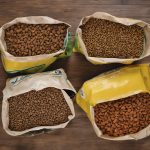In recent years, the pet food industry has seen a significant shift towards grain-free diets, fueled by the misconception that grains are mere fillers in dog food. This trend has led to an increase in the use of alternative ingredients such as pea protein, legumes, and potatoes. However, this move away from traditional grains to trendy fillers has raised concerns regarding the overall health and well-being of our canine companions, particularly in relation to heart health. It's time to reassess the role of whole grains in dog food and understand why they are not only vital but preferable to the modern fillers that have become so prevalent.
The Rise of Trendy Fillers
Grain-free dog foods often tout the benefits of their main ingredients, like pea protein, legumes (including chickpeas, lentils, and various types of beans), and potatoes, claiming they are healthier alternatives to grains. While these ingredients can provide protein and other nutrients, they don't offer the balanced nutrition that whole grains can. Instead, they have come under scrutiny for their association with canine dilated cardiomyopathy (DCM), a serious heart condition.
The Link to Heart Health
The United States Food and Drug Administration (FDA) has investigated the potential connection between grain-free diets that heavily feature legumes, potatoes, and similar ingredients, and an increased risk of DCM in dogs. DCM leads to an enlarged heart and weakened pumping ability, which can result in congestive heart failure or sudden cardiac death. The exact mechanism by which these ingredients might contribute to DCM is still under investigation, but it has raised enough concern for veterinarians to caution against feeding dogs a diet based on these trendy fillers, especially when done so to the exclusion of grains.
The Case for Whole Grains
Whole grains, contrary to popular belief, are far from mere fillers. They are packed with essential nutrients, including:
- Fiber: Aids in digestion and helps maintain a healthy weight.
- Proteins: Offer a balanced amino acid profile.
- Vitamins and Minerals: Such as B vitamins, which are crucial for energy metabolism.
- Antioxidants: Offering a range of health benefits, including reducing inflammation.
Whole grains such as brown rice, barley, and oats are more than nutritional powerhouses; they are also less likely to contribute to heart health issues in the way that legume-heavy, grain-free diets have been suggested to do. Their inclusion in dog food supports not only digestive health but also cardiovascular health.
Reconsidering Dog Food Choices
Choosing the right food for your dog means looking beyond marketing trends and focusing on what scientific research suggests is best for their health. Dog owners are advised to:
- Consult a Veterinarian: Always consult with a veterinarian or a canine nutritionist when considering changing your dog's diet, especially if you're concerned about heart health or other specific health issues.
- Read Labels Carefully: Look for dog food that lists whole grains among the first ingredients and be cautious of those that list pea protein, legumes, or potatoes at the top.
- Consider the Whole Diet: A balanced diet is key. Regardless of the base, ensuring your dog's food meets the nutritional standards set by the Association of American Feed Control Officials (AAFCO) is crucial.
In conclusion, the movement towards grain-free diets and the subsequent reliance on fillers like pea protein, legumes, and potatoes may not be in the best interest of your dog's heart health. Whole grains offer a host of benefits that these trendy alternatives cannot match. As the debate around canine nutrition continues, it's clear that whole grains should not be dismissed and deserve a place in our dogs' bowls.


